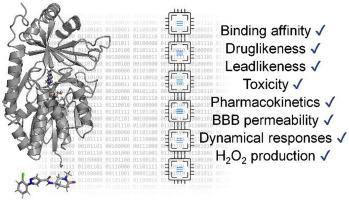Journal of Molecular Graphics and Modelling ( IF 2.7 ) Pub Date : 2020-08-04 , DOI: 10.1016/j.jmgm.2020.107701 Yılmaz Özkılıç 1 , Nurcan Ş Tüzün 1

|
Kynurenine 3-monooxygenase (KMO) regulates the levels of bioactive substances in the kynurenine pathway of tryptophan catabolism and its activity is tied to so many diseases that finding an appropriate inhibitor for KMO has become an urgent task. This especially proved to be difficult for the central nervous system related diseases due to the requirement that the supposed inhibitor should be both blood brain barrier permeable and should not cause hydrogen peroxide as a harmful side product. In this in silico study, we present our step-wise approach, whose starting point is based on the important experimental observations. To tackle the problem, a library of 7561938 structures was obtained from Zinc15 database utilizing the tranche browser. From this library, a subset of 501777 structures was determined with the considerations of their functional groups that constrain their applicability. Then, the binding affinity ranking of this set of structures was determined via virtual screening. Starting from the structures whose affinities are the highest among this subset, the ADMET properties were checked through in silico methods and the binding properties of the selected inhibitor candidates were further investigated via molecular dynamics simulations and MM/GBSA calculations. According to the computational results of this study, ZINC_71915355 has passed all the evaluations and is a potentially BBB permeable structure that can inhibit KMO. Additionally, ZINC_19827377 was identified as a new potential KMO inhibitor which may be more suitable for peripheral administration. From the in silico study presented herein, ZINC_71915355 and ZINC_19827377 structures, which showed high binding affinity without harmful H2O2 production, along with the tailored properties can now serve as powerful candidates for KMO inhibition and these hits are worth of further experimental validation.
中文翻译:

在计算机方法中,预测了新的血脑屏障渗透性结构可抑制犬尿氨酸3-单加氧酶。
Kynurenine 3-monooxygenase(KMO)调节色氨酸分解代谢的犬尿氨酸途径中生物活性物质的水平,其活性与许多疾病相关,因此寻找合适的KMO抑制剂已成为当务之急。由于要求假定的抑制剂既要能渗透血脑屏障,又不能引起过氧化氢作为有害副产物,所以对于中枢神经系统相关疾病尤其困难。在此计算机模拟研究中,我们介绍了逐步方法,其起点是基于重要的实验观察结果。为了解决该问题,使用档浏览器从Zinc15数据库获得了7561938个结构的库。从这个库中 确定了501777结构的一个子集,并考虑了其功能基团的限制。然后,通过虚拟筛选确定该组结构的结合亲和力等级。从亲和力在该子集中最高的结构开始,通过计算机方法检查了ADMET特性,并通过分子动力学模拟和MM / GBSA计算进一步研究了所选抑制剂候选物的结合特性。根据这项研究的计算结果,ZINC_71915355已通过所有评估,并且是潜在的BBB渗透性结构,可以抑制KMO。此外,ZINC_19827377被鉴定为一种新的潜在KMO抑制剂,可能更适合于外周给药。2 O 2的产生以及定制的特性现在可以用作抑制KMO的有力候选者,这些命中值值得进一步的实验验证。











































 京公网安备 11010802027423号
京公网安备 11010802027423号